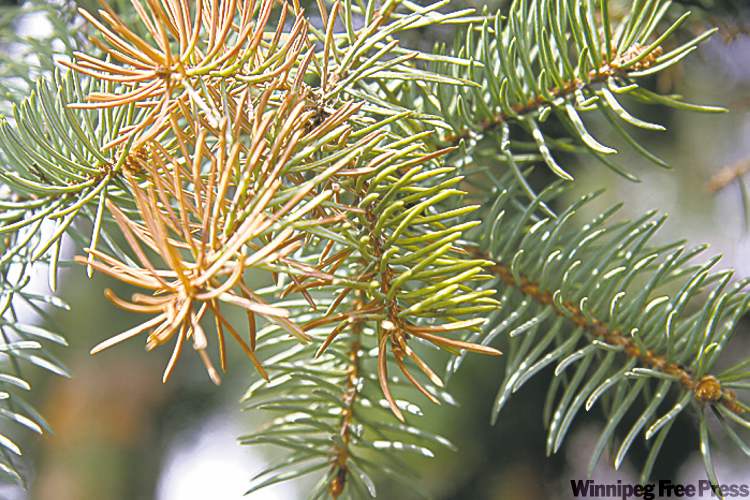TREE CARE: Fertilize spruce trees to fight disease
Advertisement
Read this article for free:
or
Already have an account? Log in here »
To continue reading, please subscribe:
Monthly Digital Subscription
$1 per week for 24 weeks*
- Enjoy unlimited reading on winnipegfreepress.com
- Read the E-Edition, our digital replica newspaper
- Access News Break, our award-winning app
- Play interactive puzzles
*Billed as $4.00 plus GST every four weeks. After 24 weeks, price increases to the regular rate of $19.00 plus GST every four weeks. Offer available to new and qualified returning subscribers only. Cancel any time.
Monthly Digital Subscription
$4.75/week*
- Enjoy unlimited reading on winnipegfreepress.com
- Read the E-Edition, our digital replica newspaper
- Access News Break, our award-winning app
- Play interactive puzzles
*Billed as $19 plus GST every four weeks. Cancel any time.
To continue reading, please subscribe:
Add Winnipeg Free Press access to your Brandon Sun subscription for only
$1 for the first 4 weeks*
*$1 will be added to your next bill. After your 4 weeks access is complete your rate will increase by $0.00 a X percent off the regular rate.
Read unlimited articles for free today:
or
Already have an account? Log in here »
Hey there, time traveller!
This article was published 05/11/2011 (5084 days ago), so information in it may no longer be current.
Phone messages and emails are piling up with homeowner worries about their spruce-tree needles turning orange-brown almost overnight.
While there’s more than one culprit, this year’s wet spring and long, hot, dry summer set a significant fungus disease called Sirococcus tip blight into motion.
This disease normally affects the current growth of spruce twigs, resulting in the death of their tips and needles. It usually shows up each spring, rarely doing significant damage.

In 2010, however, the dying needles and twig ends were strongly infected with the disease. The disease causes slightly or prominently curled ends of the twigs starting in late May or June. Infected twigs are denuded of their needles except on one side in some instances. Even this year the needles turned a straw colour in spring before falling from the twigs. Later in the summer of both years, the disease returned to change the needle colour at the ends of the twigs to a bright green-yellow. In Colorado blue spruce, this discolouration is often very dramatic. The blue needles turn bright green and then slightly discolour to a green-yellow.
Unlike most years, the dry summer weather following a very wet spring was responsible in part for establishing a new infection period on the spruces toward the end of July and in early August. The interior needles of many spruce trees naturally die of old age in mature trees. This natural death process coincided with the second wave of tip blight infection in late summer and produced a dramatic change in the colour of the needles. The colour changes varied from tree to tree from pale yellow to bright yellow to orange to bright orange to rusty brown.
Tip blight is a potentially lethal tree disease, but to date the disease has not been a common killer of spruce trees. There is a similar Sirococcus twig disease that infects pine trees, which has been aggressively killing Scots pines for a number of years.
It is too late to treat the disease this fall, but if it has affected your trees plan to do this or have it done professionally next June. The affected trees can be treated with an approved fungicide spray such as Bordeaux mixture or copper. Usually two or three spray treatments of copper 10 to 14 days apart (weather permitting) will be necessary in the spring and early summer (late May through June normally) of 2013, and again in late July to early August. I predict the disease will return in 2013 and it is likely to be as aggressively infectious as it was on many spruce trees this year.
Properly fertilizing your spruce trees either this fall or next spring will significantly help the spruces to fight the disease. Strongly infected trees should be continuously fertilized either in the fall or spring for at least three years, ideally longer. The essential nutrients in good tree fertilizers help the tree establish healthy growth to counteract the disease infections. Do not forget to water all coniferous evergreens this fall before the ground freezes.
Michael Allen M.Sc.F., RPF is a consulting urban forester and certified arborist. He owns Viburnum Tree Experts, a Manitoba company that provides objective assessments of the condition and the care required for trees and shrubs on home and business landscapes. He can be reached at 204-831-6503 or viburnumtrees@shaw.ca His website is www.treeexperts.mb.ca

